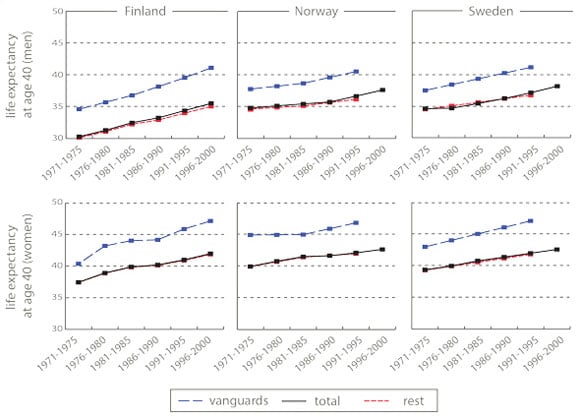
The life expectancy of married and well-educated women in Finland, Norway, and Sweden is higher than that of Japanese women who, in international comparison, have the highest life expectancy. Source: Human Mortality Database, own calculations according to unpublished data from Statistics Finland, Statistics Sweden, Statistics Norway
Researchers from the Max Planck Institute examine why life expectancy disparities between population groups have been increasing and see if there is a guide to a long life.
At age 40, Finns, Swedes, and Norwegians have reached the approximate mid-point of life. It is well known that, on average, whether an individual has more or fewer than 40 additional years to live after reaching age 40 depends on the person’s sex. But almost as important as sex in determining life expectancy is whether the person belongs to the so-called “vanguard”: If the individual is married and well educated, he or she will, on average, live five years longer than others of the same sex.
How this came to be the case and whether this group, who represent the vanguard within the population, can show the way to a higher life expectancy is the subject of a study by Domantas Jasilionis of the Max Planck Institute for Demographic Research and colleagues that has been published in the journal “Population”. The authors analyzed how the life expectancy of the vanguard group developed relative to that of the rest of the population from the early 1970s until the mid-1990s.
Generally, the country with the lowest life expectancy at the beginning of the 1970s made the most progress: since the mid-1990s in Finland, men gained an average of four years of life, while women gained an average of 3.5 years. Over the same period, Swedes gained an average of around 2.5 years of life, and Norwegians gained an average of two years; although in these two countries, life expectancy increased more among women than among men. Finland, which had previously lagged behind its Nordic neighbors in terms of life expectancy, was able to catch up to Sweden and Norway.
But these figures were far higher among married and highly educated women and men: between the start of the 1970s and the mid-1990s, the Finnish women in this vanguard group gained an average of 5.5 years of life, while the Finnish men in this group gained an average of five years. The gap between the different population groups was greatest in Finland: in the 1970s the men in the vanguard group in Finland were living an average of 4.5 years longer than the rest of the population, but at the end of the 1990s members of this group were living an average of 5.6 years longer. Thus, the vanguard group not only had a much higher life expectancy; their life expectancy also increased more than that of the rest of the population.
Eight years between “vanguard” and average
In the other two countries as well the gap between the vanguard group and the rest of the population widened among both men and women.
We can see how far apart the average life expectancy levels are from the potential levels by looking at a narrowly defined vanguard group: women who are married and highly educated. At the end of the study period, the women in this group were, on average, living eight years longer than the rest of the population. There are no signs that this gap could be narrowing, or that the life expectancy gains of this female vanguard group will be lower in the future.
Although Jasilionis and his colleagues chose to focus in their analysis on three relatively egalitarian societies—Finland, Sweden, and Norway—they found considerable differences between the population groups in each of these countries. The gaps between population groups were shown to be even larger than the differences between countries, as a comparison with Japan, the country with the highest life expectancy in the world, demonstrates.
These disparities have been attributed to the relatively low rates of mortality from cardiovascular diseases among people who are married and highly educated. Due to a decline in the prevalence of these diseases, the male vanguard group in Sweden and Norway gained 2.5 years of life, while the rest of the male population gained just 1.6 years in Norway and 1.7 years in Sweden. Among Finnish men there was a similar gap between the vanguard group and the rest of the population. However, mortality from cardiovascular diseases decreased to a much greater extent in both male population groups in Finland, with the vanguard group gaining 3.7 years of life and the rest of the male population gaining 2.9 years.
These developments show that the progress that has been made in treating cardiovascular diseases has not yet reached all segments of the population. This pattern can be observed in international comparisons. Whether life expectancy continued to rise between the 1970s and the 1990s, as was the case in western Europe; or whether it stagnated, as was the case in many eastern European countries; depended in large part on the extent to which each country was successful in treating cardiovascular diseases.
Disparities based on anthropogenic causes of death
In Sweden, Norway, and Finland all other causes of death were of secondary importance. Of the trends related to other causes, the most notable was the reduction in cancer mortality (with tobacco-related cancers excluded) among all women and among Swedish men of the vanguard group. In Norway, by contrast, there was an overall increase in cancer except among the female vanguard group. This was also the case for smoking-related cancers, even though the rates of these cancers were higher among almost all women at the end of the 1990s than at the start of the study period. However, the rates of smoking-related cancers increased to a lesser extent among the female vanguard group than among the rest of the female population.
In general, the authors observed, the rates of so-called anthropogenic causes of death—such as smoking- or alcohol-related diseases, traffic accidents, murders, and suicides—were considerably lower among the vanguard groups than among the other population groups. Even in egalitarian societies there appear to be differences between groups in terms of health care access, lifestyle, and social and environmental conditions. It is also likely that in addition to differences in material conditions, other factors affect mortality, including psychological health and the sense of control over one’s own life.
The authors therefore argue that the less advantaged segments of the population cannot be expected to follow the life expectancy trajectory of the vanguard group, albeit with a delay. Instead, they posit, that mortality among less privileged groups will likely follow a separate path. These patterns also appear to have country-specific characteristics. The differences in the levels of progress that have been made in fighting cancer and other causes of death among the different vanguard groups can point to new approaches to prolonging life; and, after the successful treatment of cardiovascular diseases, mark the start of a new health revolution in the three countries studied.
Reference: “Do vanguard populations pave the way towards higher life expectancy for other population groups?” by Domantas Jasilionis, Vladimir M. Shkolnikov, Evgueni M. Andreev, Dmitri A. Jdanov, Denny Vågerö, France Meslé and Jacques Vallin, 25 April 2015, Population: English Edition.
PDF









Be the first to comment on "Is There a Guide to Long Life? Scientists Examine Life Expectancy Disparities between Population Groups"